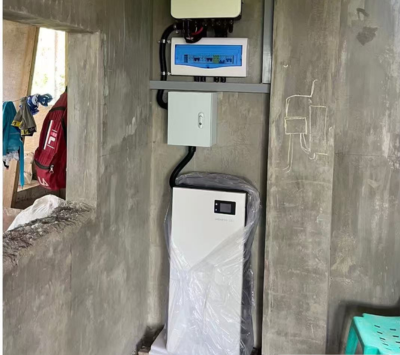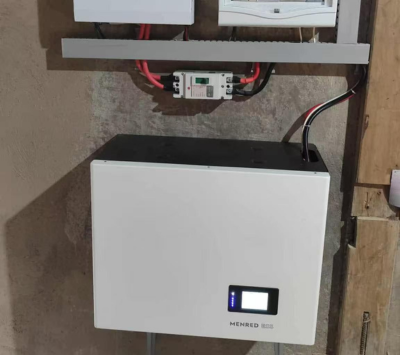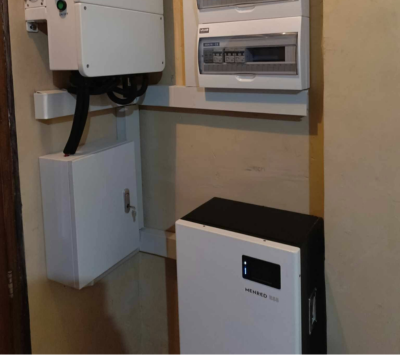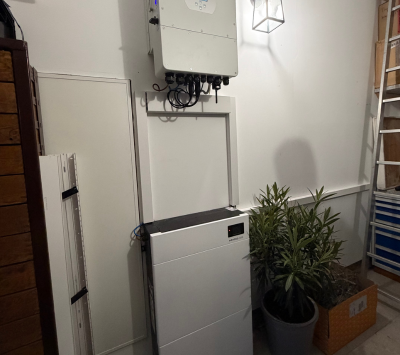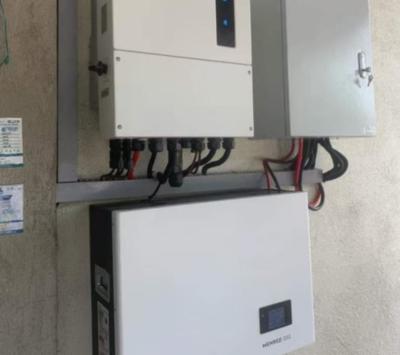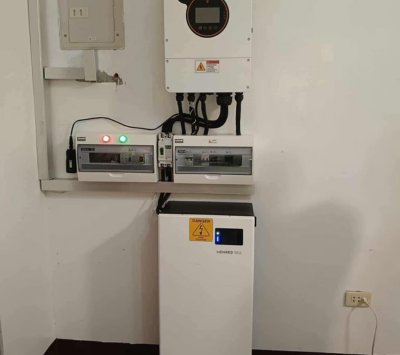MENRED ESS is setting a benchmark in the energy solutions sector with its LiFePO4 batteries. Our products have not only passed the “IEC 62619:2022” certification but also met the stringent requirements of the “IEC 61000-1/3” standard. This dual achievement underscores our unwavering commitment to quality, safety, and electromagnetic compatibility in our battery technology, Certificates from TUV Nord.
The Significance of IEC 62619:2022 and IEC 61000-1/3 Standards: While “IEC 62619:2022” focuses on the safety of industrial-use batteries, “IEC 61000-1/3” addresses their electromagnetic compatibility (EMC). EMC is crucial in ensuring that electronic devices operate without interference from or causing interference to other electronic devices. The certification asserts that MENRED ESS’s batteries are not only safe but also harmoniously coexist with other electronic systems, a vital aspect in industrial settings.

DC Voltage Withstand Test for Lithium Batteries
Testing Voltage: 2.5 kV
Testing Current:7.5 mA
Testing Duration: 60 second
The DC Voltage Withstand Test is a crucial safety assessment for lithium batteries, ensuring they can operate safely under high voltage conditions without malfunctioning. This test is essential for verifying the battery’s insulation performance and ensuring overall safety under extreme conditions.
During the test, a specific DC voltage, which is usually higher than the battery’s normal operating voltage, is applied between the positive and negative terminals of the battery. This voltage is maintained for a predetermined duration, varying from a few seconds to several minutes, depending on the standards and battery type. Throughout the test, the battery’s response is closely monitored to record any signs of abnormality or failure.
Key parameters of this test include the magnitude of the test voltage and the insulation resistance of the battery. The battery should maintain adequate insulation resistance to prevent current leakage under the high voltage.
Safety is paramount during the DC Voltage Withstand Test, necessitating controlled environments and professional handling. Proper testing equipment is essential to ensure the safety of both personnel and apparatus.
This type of test typically adheres to specific international or regional standards, such as those set by the IEC or UL. These standards dictate the exact test voltages, duration, and acceptable performance criteria.

Temperature Rise Test Results
| Sample No. | OCV before test, (Vdc) | Maximum charging current Imax, (A) | Maximum voltage of cell, (Vdc) | Maximum voltage of battery, (Vdc) | Max. temp of out surface of DUT enclosure (℃) DUT | Test result |
| 1# | 48.34 | 90 | 3.683 | 58.42 | 39.6 | NE; NF; NC; NV; NS; NL; NR; NP |
| single fault | 49.51 | 90 | 3.686 | 58.29 | 43.1 | NE; NF; NC; NV; NS; NL; NR; NP |
| Note: NE = no explosion; NF = no fire; NC=not reach Combustible vapor concentrations; NV=no toxic vapor release; NS=no Electric shock hazard (dielectric breakdown); NL = no leakage; NR = no rupture; NP = no loss of protection controls | ||||||

Single battery cell – normal state

Single battery cell (charging MOS failure)
Battery Temperature Rise Testing: A Key Step in Ensuring Safety and Performance
Battery temperature rise testing is a critical process in assessing and ensuring the safety and performance of batteries. This test focuses on monitoring the temperature changes of a battery under normal operation and extreme conditions. For all types of batteries, including lithium batteries, temperature rise testing is an essential part of ensuring long-term stability and safety.
Importance of the Test
- Preventing Overheating: Batteries can heat up during charging and discharging cycles. Temperature rise testing ensures that batteries do not overheat under these conditions, averting potential safety hazards.
- Evaluating Thermal Management Systems: The test assesses the effectiveness of a battery’s thermal management system, ensuring stable operation under high loads.
Testing Process
- Applying Load: Specific charging and discharging loads are applied to the battery to simulate real-world usage.
- Monitoring Temperature: Continuous monitoring of temperature changes in the battery throughout the test.
- Assessing Results: Evaluating whether the battery meets safety and performance standards based on test outcomes.
Standards and Regulations
- Adhering to international standards such as IEC and UL ensures the test results are universally comparable and reliable.
Battery temperature rise testing is not only a necessary step in the manufacturing and design process of batteries but also key to ensuring user safety and enhancing battery performance. Understanding and implementing effective temperature rise testing helps battery manufacturers improve product quality and safety, while offering consumers more reliable energy solutions.

LiFePO4 battery Short-Circuit protection test results
| Sample No. | Ambient temperature, °C | OCV before test, (Vdc) | Resistance, mΩ | Maximum short-circuit current, A | Duration at Max short circuit current, s | Test result |
| 3# | 26.58 | 53.49 | 19.8 | 642 | 0.0016S | protection in the circuit has operated and the temperature on the center module has peaked or steady state. |
| single fault | 27.3 | 53.81 | 19.6 | 646 | 0.0016S |

Battery pack Short Circuit – Voltage Current Curve (Normal State)

Battery pack Short Circuit – Voltage Current Curve (Fuse Short Circuit)

Battery pack short-circuit-temperature curve (normal state)

Battery pack Short Circuit-Temperature Curve (Fuse Short Circuit)
Drop Test for Batteries under IEC 62619 Standard

In the realm of renewable energy storage, ensuring the robustness and safety of lithium iron phosphate (LiFePO4) batteries is paramount. The drop test, as defined under the IEC 62619 standard, serves as a critical assessment of a battery’s structural integrity and operational reliability following physical impacts. This procedure simulates real-world scenarios where batteries might experience falls or sudden impacts, assessing their resilience in maintaining performance standards without compromising safety.
The significance of the IEC 62619 drop test extends beyond mere compliance. It underscores a commitment to delivering high-quality, durable energy storage solutions. For manufacturers and consumers alike, understanding the rigors of this test offers insights into the reliability and safety of photovoltaic storage systems, reinforcing trust in lithium-based technologies for sustainable energy solutions.
Incorporating cutting-edge methodologies, the IEC 62619 drop test evaluates batteries through a series of controlled drops from specified heights, at various angles, ensuring a comprehensive assessment of potential vulnerabilities. This stringent evaluation process highlights the importance of advanced materials and innovative design in enhancing the resilience of LiFePO4 batteries against physical shocks, thereby safeguarding the efficiency and longevity of renewable energy storage systems.
IEC 62619 and Thermal Runaway: A Safety Test Overview
In the rigorous landscape of battery safety standards, the IEC 62619’s thermal runaway test stands out as a pivotal evaluation for lithium iron phosphate (LiFePO4) batteries. This test simulates extreme conditions to assess a battery’s reaction to overheating, a scenario that could lead to catastrophic failure if not properly managed. Thermal runaway is a condition where an increase in temperature changes the conditions in a way that causes a further increase in temperature, often leading to a destructive reaction. The IEC 62619 standard mandates a series of procedures to meticulously evaluate the battery’s ability to withstand such conditions without compromising its structural integrity or functionality. Understanding and passing the thermal runaway test is crucial for manufacturers to ensure the highest levels of safety and reliability in their energy storage solutions, aligning with global safety regulations and consumer expectations for sustainable and safe renewable energy technologies.

In a recent thermal runaway test conducted on our lithium batteries, a fascinating observation was made regarding their safety features. The test involved a setup of 16 battery cells, where the fourth cell was equipped with two heating plates. The first plate was externally heated to induce thermal runaway in the cell, aiming to monitor its impact on the adjacent 15 cells. The results were remarkable. Upon heating, the targeted cell emitted smoke but did not lead to an explosion or ignite a fire, suggesting no thermal runaway occurred in the surrounding cells. Subsequently, when the second heating plate was activated to induce another thermal runaway, the outcome remained the same—emission of smoke without any explosion or fire, further reinforcing the battery’s safety credentials.
The entire test spanned about an hour, yet for accessibility and engagement, we have condensed the footage into a rapid showcase, sped up to 5000% of the original speed.
This rigorous assessment highlights the exemplary safety of our lithium batteries under the stringent standards of IEC62619’s thermal runaway tests. It reassures users of the robustness and reliability of our batteries, making them an ideal choice for applications demanding high safety and stability.
For industry professionals and enthusiasts seeking secure and reliable energy solutions, this test not only underscores our commitment to safety but also aligns with the critical benchmarks of IEC62619, providing peace of mind in the operational integrity of lithium batteries.
Battery Short-Circuit Protection: An Essential Safety Mechanism
Battery short-circuit protection is a critical safety feature designed to prevent overheating, damage, or even fire in the event of a short circuit. This protection is particularly vital for all types of batteries, especially those with high energy densities like lithium batteries. During a short circuit, the internal current of the battery can spike dramatically, potentially leading to severe thermal incidents and chemical reactions.
How Short-Circuit Protection Works
- Current Monitoring: The short-circuit protection mechanism detects potential short circuits by monitoring the battery’s current.
- Circuit Interruption: Upon detecting abnormally high current, the protection system swiftly disconnects the circuit to prevent further current flow.
Importance and Benefits
- Damage Prevention: Protects the battery from overheating and damage caused by short circuits.
- Enhanced Safety: Increases the safety of batteries during regular use and under extreme conditions.
- Life Extension: Prevents unnecessary wear due to short circuits, thereby extending the battery’s lifespan.
Design Considerations for Short-Circuit Protection
- Accuracy and Reliability: Ensures the protection mechanism accurately and reliably responds to actual short-circuit conditions.
- Rapid Response: The ability to quickly disconnect the circuit at the onset of a short circuit is key to preventing damage.
Conclusion
Short-circuit protection is a fundamental component of battery design and usage, crucial for ensuring the safety and stability of batteries in various environments. From personal consumer electronics to industrial applications, short-circuit protection provides the necessary safeguard.
In the field of energy solutions, MENRED ESS continues to push the limits of innovation and safety. We proudly announce that our LiFePO4 battery series has successfully passed the “IEC 62619:2022” standard certification, a significant milestone in the industrial battery field. This certification not only signifies our product’s international recognition but also represents our commitment to enhancing energy efficiency and safety.
Global Impact of the IEC 62619:2022 Standard: The “IEC 62619:2022” is the latest safety standard for industrial equipment batteries by the International Electrotechnical Commission (IEC). Its wide applicability extends beyond China to Europe, Australia, Japan, and more, offering a unified safety benchmark for energy storage solutions worldwide.
Main Scope and Testing of the Standard:
- Fixed Applications: Suitable for electronic communication, UPS, emergency power devices, power reserves, and similar equipment.
- Motive Applications: Including forklifts, golf carts, Automated Guided Vehicles (AGV), railway and marine transportation vehicles, etc.
The testing scope covers product structural design, safety testing, and functional safety assessment, including external short circuit, impact, drop, thermal abuse, overcharging, forced discharge, internal short circuit, and thermal propagation tests.
Key Changes from IEC 62619:2017 to 2022: The new standard, compared to the 2017 edition, includes major changes such as:
- Added requirements for moving parts, improving the safety standards of power systems.
- Additional requirements for hazardous live parts, enhancing battery isolation and protection.
- Additional battery system design requirements, ensuring overall battery system safety and reliability.
- New system lock requirements, enhancing battery system safety control.
- New EMC requirements, boosting the battery’s electromagnetic compatibility.
- Additional laser-induced thermal propagation processes, increasing battery safety in extreme conditions.
MENRED ESS’s Innovation and Design Philosophy: In the design and development process, MENRED ESS pays special attention to meeting and exceeding these new standards. Our product design team meticulously considers each new requirement, from the micro-components of the battery to the overall system design, ensuring every LiFePO4 battery operates safely and efficiently under the most stringent conditions.
The certification of MENRED ESS’s LiFePO4 batteries under the latest IEC 62619:2022 standard not only demonstrates our products’ exceptional performance in industrial applications but also affirms our leadership in battery technology innovation and safety. We continue to commit to providing our global customers with higher-standard, safer, and more reliable energy solutions, paving the way for a more sustainable energy future.
The Significance of IEC 62619:2022 and IEC 61000-1/3 Standards:
While “IEC 62619:2022” focuses on the safety of industrial-use batteries, “IEC 61000-1/3” addresses their electromagnetic compatibility (EMC). EMC is crucial in ensuring that electronic devices operate without interference from or causing interference to other electronic devices. The certification asserts that MENRED ESS’s batteries are not only safe but also harmoniously coexist with other electronic systems, a vital aspect in industrial settings.
Comprehensive Testing and Compliance: Our LiFePO4 batteries underwent rigorous testing for both standards. For IEC 62619:2022, tests included external short circuit, thermal abuse, and overcharging, among others. In contrast, the IEC 61000-1/3 certification process involved meticulous evaluation of the batteries’ electromagnetic emissions and susceptibility, ensuring they meet the highest standards for EMC.
IEC 61000-1/3: A Closer Look: IEC 61000-1/3 sets the benchmark for electromagnetic compatibility, focusing on aspects like:
- Radiated emissions: Ensuring that the battery’s operation does not emit interference that could disrupt other devices.
- Conducted emissions: Assessing the electromagnetic energy transmitted through power lines and cables.
- Immunity tests: Evaluating the battery’s resilience against external electromagnetic interference, ensuring consistent performance even in environments with high electromagnetic activity.
Innovations in Battery Technology: At MENRED ESS, the adherence to both IEC 62619:2022 and IEC 61000-1/3 standards reflect our holistic approach to product development. Our engineering teams have innovated at every level – from the chemistry of the battery cells to the design of the battery management system (BMS) – ensuring optimal performance, safety, and EMC compliance.
Achieving both IEC 62619:2022 and IEC 61000-1/3 certifications marks a significant milestone for MENRED ESS and our LiFePO4 battery technology. It’s a testament to our commitment to providing products that are not just powerful and efficient but also safe and compatible in diverse industrial environments. We are proud to lead the way in setting new standards in the energy solutions industry.



